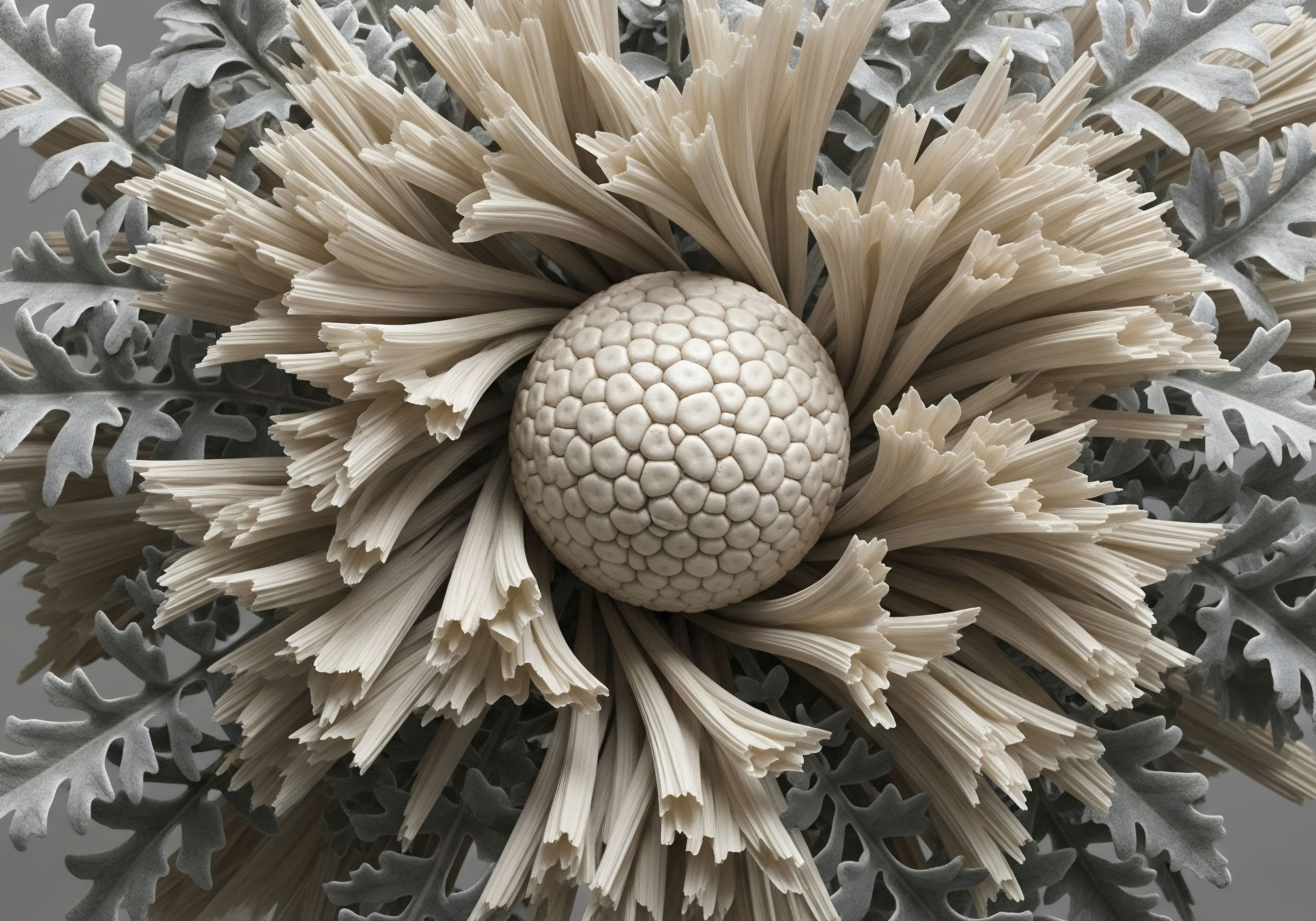

Fundamentals
That feeling of diminished vitality, the subtle or pronounced shift in your sense of self and desire, is a valid and deeply personal experience. It often begins as a quiet question, a sense of disconnect from the energy you once knew. Your body communicates its state of being through a complex internal language, a series of biochemical messages.
When we discuss monitoring sexual health through lifestyle changes, we are truly talking about learning to listen to this language. The most direct way to interpret these messages is through specific laboratory markers. These are quantifiable data points in your blood that reflect the intricate workings of your endocrine system, the very system that governs energy, mood, metabolism, and sexual function.
Understanding these markers is the first step in translating your subjective feelings into an objective roadmap for reclaiming your well-being. It provides a baseline, a starting point from which every positive change you make ∞ be it in nutrition, exercise, or stress management ∞ can be measured and validated. This process is about building a partnership with your own biology, using precise information to guide your journey back to optimal function.
At the heart of this conversation are the primary sex hormones. In the male body, testosterone is a central molecule for maintaining libido, muscle mass, bone density, and a sense of assertive well-being. For the female body, a delicate balance of estrogens and progesterone governs the menstrual cycle, reproductive health, and also contributes significantly to mood and desire.
Testosterone plays a vital role in female health as well, influencing libido, energy, and cognitive clarity. When these hormonal levels shift due to age, stress, or other lifestyle factors, the effects are felt systemically. The fatigue, brain fog, or low libido you may be experiencing are often direct physiological signals of these changes.
By measuring these hormones, we are taking the first, most critical step in identifying the root cause of these symptoms. It moves the conversation from one of vague complaints to one of targeted, evidence-based action. This initial data provides the foundation upon which a truly personalized wellness protocol is built.

The Core Hormonal Panel
To begin this journey of understanding, a foundational lab panel provides a snapshot of your primary hormonal status. This initial set of tests is designed to assess the key players in your endocrine orchestra, giving a clear indication of where any imbalances may lie. Think of it as an initial reconnaissance mission into your own biology.

Total and Free Testosterone
Measuring testosterone is a cornerstone of assessing sexual health for both men and women. Total testosterone quantifies the entire amount of the hormone in your bloodstream. This number includes testosterone that is bound to proteins and testosterone that is freely available for your tissues to use.
The free testosterone measurement is a more direct indicator of the hormone’s biological activity, representing the portion that can actively bind to receptors in your cells to exert its effects on libido, energy, and muscle function. For men, low levels are directly linked to symptoms of andropause. In women, even small deficiencies can impact sexual desire and overall vitality.

Estradiol E2
Estradiol is the most potent form of estrogen and is a critical hormone for both female and male health. In women, it is essential for regulating the menstrual cycle and maintaining bone density and cardiovascular health. In men, an appropriate level of estradiol is necessary for modulating libido, erectile function, and sperm production.
Imbalances, either too high or too low, can cause significant issues. High levels in men, often a result of testosterone converting into estrogen, can lead to side effects like water retention and gynecomastia. In women, fluctuations are a hallmark of perimenopause and can lead to a wide array of symptoms.

Sex Hormone-Binding Globulin SHBG
Sex Hormone-Binding Globulin is a protein produced by the liver that binds to sex hormones, primarily testosterone and estradiol. Its function is to transport these hormones through the bloodstream. A high SHBG level means that more of your hormones are bound and inactive, leaving less free hormone available for your tissues.
Conversely, a low SHBG level results in higher levels of free, bioavailable hormones. Measuring SHBG is therefore essential for correctly interpreting your total testosterone levels. It provides the context needed to understand your true hormonal status. Lifestyle factors like diet and insulin sensitivity can significantly influence SHBG levels, making it a key marker to monitor during any wellness protocol.


Intermediate
Advancing beyond the foundational markers requires an appreciation for the body’s intricate regulatory systems. Your hormonal output is governed by a sophisticated feedback mechanism known as the Hypothalamic-Pituitary-Gonadal (HPG) axis. This axis is the central command and control for your entire reproductive and sexual endocrine system.
The hypothalamus, a region in your brain, releases Gonadotropin-Releasing Hormone (GnRH). This signals the pituitary gland, also in the brain, to release two key messenger hormones ∞ Luteinizing Hormone (LH) and Follicle-Stimulating Hormone (FSH).
These pituitary hormones then travel through the bloodstream to the gonads (the testes in men and the ovaries in women), instructing them to produce sex hormones like testosterone and estrogen. These end-product hormones then signal back to the brain to moderate the release of GnRH, LH, and FSH, creating a self-regulating loop.
When we analyze markers like LH and FSH, we are essentially eavesdropping on the conversation between your brain and your gonads. This allows us to determine if a hormonal issue originates from the brain’s signaling (a secondary issue) or from the gonads’ production capacity (a primary issue). This level of detail is fundamental for designing effective therapeutic interventions, such as Testosterone Replacement Therapy (TRT) or fertility protocols.
Monitoring the full Hypothalamic-Pituitary-Gonadal axis provides a complete picture of hormonal signaling, from brain to gonad.
For instance, in a man experiencing symptoms of low testosterone, observing high levels of LH and FSH alongside low testosterone would suggest a primary testicular issue; the brain is calling for testosterone, but the testes are unable to respond adequately.
Conversely, seeing low levels of LH, FSH, and testosterone would point toward a secondary, or central, issue originating in the hypothalamus or pituitary. This distinction is vital. The treatment for primary hypogonadism is often direct testosterone replacement.
A secondary issue might be addressed with protocols using agents like Gonadorelin or Enclomiphene, which are designed to stimulate the pituitary’s own production of LH and FSH, thereby encouraging the testes to produce testosterone naturally. This systems-based approach ensures that interventions are targeted to the specific point of dysfunction within the HPG axis, leading to more sustainable and effective outcomes.

Advanced Hormonal and Metabolic Markers
To gain a comprehensive understanding, we must look at a wider array of biomarkers that influence and are influenced by the HPG axis. These markers provide deeper insights into metabolic health, stress pathways, and overall endocrine function, all of which are interconnected with sexual vitality.

Key Pituitary and Adrenal Hormones
These hormones add another layer of diagnostic clarity, revealing the influence of the pituitary gland and the adrenal system on sexual health.
- Luteinizing Hormone (LH) As the direct signal from the pituitary to the gonads to produce sex hormones, LH is a critical marker. In men, it stimulates the Leydig cells in the testes to produce testosterone. In women, the mid-cycle LH surge triggers ovulation. Its level helps diagnose the origin of low testosterone or ovulatory dysfunction.
- Follicle-Stimulating Hormone (FSH) This hormone is essential for sperm production (spermatogenesis) in men and for the development of ovarian follicles in women. Elevated FSH can be an indicator of declining gonadal function or menopause.
- Prolactin Produced by the pituitary gland, high levels of prolactin can suppress the HPG axis by inhibiting GnRH release. This directly leads to reduced testosterone production in men and can disrupt menstrual cycles in women, often resulting in low libido. It is an important marker to check, as elevated levels can sometimes indicate a benign pituitary tumor called a prolactinoma.
- DHEA-S (Dehydroepiandrosterone Sulfate) This is an abundant precursor hormone produced by the adrenal glands. The body converts DHEA-S into other hormones, including testosterone and estrogen. Levels naturally decline with age, and measuring DHEA-S can provide insight into the overall function of the adrenal system, which is closely tied to stress response and energy levels.

What Are the Implications of Insulin Resistance on Hormonal Panels?
Metabolic health is inextricably linked to hormonal balance. Chronic elevations in blood sugar and insulin can wreak havoc on the endocrine system. Monitoring key metabolic markers is therefore a non-negotiable aspect of a comprehensive sexual health assessment. Insulin resistance, a condition where the body’s cells do not respond effectively to insulin, forces the pancreas to produce more of this hormone.
Persistently high insulin levels can suppress SHBG production in the liver, leading to an unfavorable ratio of free to total testosterone. It can also promote inflammation, which further disrupts hormonal signaling. A man or woman can have a “normal” total testosterone level, yet suffer from symptoms of hormonal imbalance because their metabolic health is compromising how that testosterone is used in the body.
This is why a thorough evaluation must include the following metabolic markers, as they provide critical context to the hormonal panel.
| Metabolic Marker | Function and Relevance to Sexual Health |
|---|---|
| Hemoglobin A1c (HbA1c) | Provides a three-month average of blood sugar levels. Elevated HbA1c is a diagnostic marker for pre-diabetes and diabetes, conditions strongly associated with erectile dysfunction and low libido due to vascular and nerve damage. |
| Fasting Insulin | Measures the amount of insulin in the blood after an overnight fast. High levels indicate insulin resistance, which can lower SHBG, increase inflammation, and contribute to hormonal imbalances. |
| Comprehensive Lipid Panel | Includes LDL, HDL, Triglycerides, and Total Cholesterol. Poor lipid profiles are linked to atherosclerosis (hardening of the arteries), which can impair blood flow to the genital organs, directly impacting erectile and arousal responses. |
| High-Sensitivity C-Reactive Protein (hs-CRP) | A sensitive marker for systemic inflammation. Chronic inflammation can suppress the HPG axis, impair testosterone production, and is a root cause of many chronic diseases that impact sexual function. |


Academic
A sophisticated analysis of sexual health requires a deep exploration of the intersection between endocrinology and metabolism at a molecular level. The physiological state of sexual vitality is predicated on a sensitive and responsive Hypothalamic-Pituitary-Gonadal (HPG) axis, which itself is profoundly influenced by the body’s metabolic status.
The concept of the “metabolic syndrome” ∞ a constellation of conditions including insulin resistance, hypertension, dyslipidemia, and central obesity ∞ offers a powerful framework for understanding a significant portion of non-organic sexual dysfunction. The pathophysiology of metabolic syndrome creates a systemic environment of inflammation and hormonal dysregulation that directly impairs the HPG axis at multiple points.
For example, pro-inflammatory cytokines such as Tumor Necrosis Factor-alpha (TNF-α) and Interleukin-6 (IL-6), which are chronically elevated in states of obesity and insulin resistance, have been shown to exert a suppressive effect on GnRH neurons in the hypothalamus. This reduces the pulsatile release of GnRH, leading to attenuated LH and FSH secretion from the pituitary and, consequently, diminished gonadal steroidogenesis. This mechanism explains the high prevalence of hypogonadism in men with type 2 diabetes and obesity.
The systemic inflammation characteristic of metabolic syndrome actively suppresses the central nervous system’s command signals for hormone production.
Furthermore, the liver’s role as a metabolic and endocrine organ is central to this interplay. Insulin resistance and the associated condition of non-alcoholic fatty liver disease (NAFLD) directly impact the synthesis of Sex Hormone-Binding Globulin (SHBG). Hyperinsulinemia, a hallmark of insulin resistance, downregulates the hepatic gene expression of SHBG.
The clinical consequence is a reduction in circulating SHBG levels. While this may transiently increase the calculated free testosterone fraction, the overall hypogonadal state induced by central suppression and increased aromatase activity in adipose tissue means the absolute amount of available testosterone is still deficient.
A comprehensive lab assessment in this context must therefore be interpreted through a systems-biology lens, where markers like hs-CRP, fasting insulin, and a lipid panel are viewed as direct modulators of the endocrine results. A low total testosterone, low SHBG, and elevated hs-CRP in an overweight individual paints a clear picture of metabolically-induced hypogonadism, guiding therapy toward aggressive lifestyle modification and metabolic control as a primary intervention, with hormonal optimization protocols serving a synergistic role.

How Does Adipose Tissue Function as an Endocrine Organ?
Adipose tissue, particularly visceral adipose tissue, functions as a highly active endocrine organ. It secretes a variety of adipokines and inflammatory cytokines that have profound systemic effects. One of the most relevant enzymes in this context is aromatase.
Adipose tissue is a primary site of aromatase expression, the enzyme responsible for the irreversible conversion of androgens (like testosterone) into estrogens (like estradiol). In conditions of excess adiposity, this conversion is significantly upregulated. This process has two major negative consequences for male sexual health. First, it directly reduces the circulating pool of testosterone.
Second, the resulting elevation in estradiol levels exerts a potent negative feedback on the HPG axis, further suppressing LH secretion and testicular testosterone production. This creates a self-perpetuating cycle of low testosterone and increased fat mass. Monitoring the testosterone-to-estradiol (T/E) ratio is a clinically useful way to assess this aromatase activity.
A low ratio can be a clear indicator that excessive aromatization is a key factor in a man’s hypogonadal state and may warrant the use of an aromatase inhibitor, such as Anastrozole, as part of a comprehensive TRT protocol.

The Role of Peptide Therapeutics and Their Markers
The field of personalized wellness has expanded to include peptide therapies, which are short chains of amino acids that act as signaling molecules in the body. These can be used to target specific pathways related to growth hormone secretion, tissue repair, and sexual function. Monitoring their efficacy requires looking at both direct and indirect biomarkers.
- Growth Hormone Peptides (Sermorelin, Ipamorelin/CJC-1295) These peptides, known as secretagogues, stimulate the pituitary gland to release its own growth hormone (GH). The primary biomarker to monitor their effect is Insulin-Like Growth Factor 1 (IGF-1). GH produced by the pituitary travels to the liver, where it stimulates the production of IGF-1. Therefore, an increase in serum IGF-1 levels is a direct indicator of a successful response to GH peptide therapy. Baseline and follow-up IGF-1 tests are essential for dose titration and ensuring levels remain within a safe and optimal physiological range.
- PT-141 (Bremelanotide) This peptide functions differently, acting directly on the central nervous system. It is a melanocortin receptor agonist, and its mechanism of action for improving sexual arousal is related to its effects on dopamine pathways in the brain. There is no direct downstream blood marker to measure its efficacy. Monitoring for PT-141 is based on subjective patient-reported outcomes regarding libido and arousal response. Its use highlights a domain of sexual health where a patient’s lived experience is the primary metric of success.
| Systemic Condition | Primary Lab Marker | Correlated Hormonal Impact | Clinical Implication for Sexual Health |
|---|---|---|---|
| Insulin Resistance | Elevated Fasting Insulin / HbA1c | Decreased SHBG, Increased Aromatase Activity | Leads to lower total testosterone and an unfavorable T/E ratio, contributing to low libido and erectile dysfunction. |
| Chronic Systemic Inflammation | Elevated hs-CRP / TNF-α | Suppression of GnRH, LH, and FSH signaling | Results in centrally-mediated hypogonadism, reducing the body’s intrinsic drive to produce sex hormones. |
| Thyroid Dysfunction | Abnormal TSH, Free T3, Free T4 | Alters SHBG levels and can impact prolactin secretion | Both hypothyroidism and hyperthyroidism are strongly linked to sexual dysfunction, including low desire and erectile issues. |
| Pituitary Hyperprolactinemia | Elevated Prolactin | Suppresses the HPG axis by inhibiting GnRH | A direct and potent cause of low libido and secondary hypogonadism in both men and women. |

References
- Travison, T. G. et al. “A population-level decline in serum testosterone levels in American men.” The Journal of Clinical Endocrinology & Metabolism, vol. 92, no. 1, 2007, pp. 196-202.
- Mulligan, T. et al. “Prevalence of hypogonadism in males aged at least 45 years ∞ the HIM study.” International Journal of Clinical Practice, vol. 60, no. 7, 2006, pp. 762-769.
- Bhasin, S. et al. “Testosterone therapy in men with hypogonadism ∞ an Endocrine Society clinical practice guideline.” The Journal of Clinical Endocrinology & Metabolism, vol. 103, no. 5, 2018, pp. 1715-1744.
- Goldman, A. L. et al. “A review of the diagnosis and treatment of testosterone deficiency in men.” The Journal of Urology, vol. 197, 2017, S30-S36.
- Corona, G. et al. “The role of testosterone in erectile dysfunction.” Nature Reviews Urology, vol. 8, no. 1, 2011, pp. 46-56.
- Davis, S. R. et al. “Testosterone for low libido in postmenopausal women ∞ a randomized controlled trial.” New England Journal of Medicine, vol. 359, no. 19, 2008, pp. 2005-2017.
- Dandona, P. and Dhindsa, S. “Update ∞ Hypogonadotropic hypogonadism in type 2 diabetes and obesity.” The Journal of Clinical Endocrinology & Metabolism, vol. 96, no. 9, 2011, pp. 2643-2651.
- Hammond, G. L. “Diverse roles for sex hormone-binding globulin in reproduction.” Biology of Reproduction, vol. 85, no. 3, 2011, pp. 431-441.

Reflection
The data contained within these lab reports offers a profound opportunity. It provides a language for the very feelings and symptoms you have been experiencing, translating your personal narrative into a biological one. This information is the beginning of a new conversation with your body, one founded on objective evidence and personalized insight.
The path forward involves using this knowledge not as a final judgment, but as a dynamic guide. Each lifestyle adjustment, each nutritional choice, and each therapeutic protocol can be monitored and refined based on how these markers respond. This journey is about recalibrating your unique biological system.
The ultimate goal is to move beyond managing symptoms and toward creating a sustainable state of vitality and function. The numbers are simply the tools; the work is in applying the insights they provide to build a more resilient, energetic, and connected version of yourself.

Glossary

sex hormones

low libido

total testosterone

sex hormone-binding globulin

luteinizing hormone

pituitary gland

low testosterone

hpg axis

metabolic health

prolactin

dhea-s

insulin resistance

metabolic markers

metabolic syndrome

aromatase activity

adipose tissue

hs-crp

trt protocol

growth hormone




